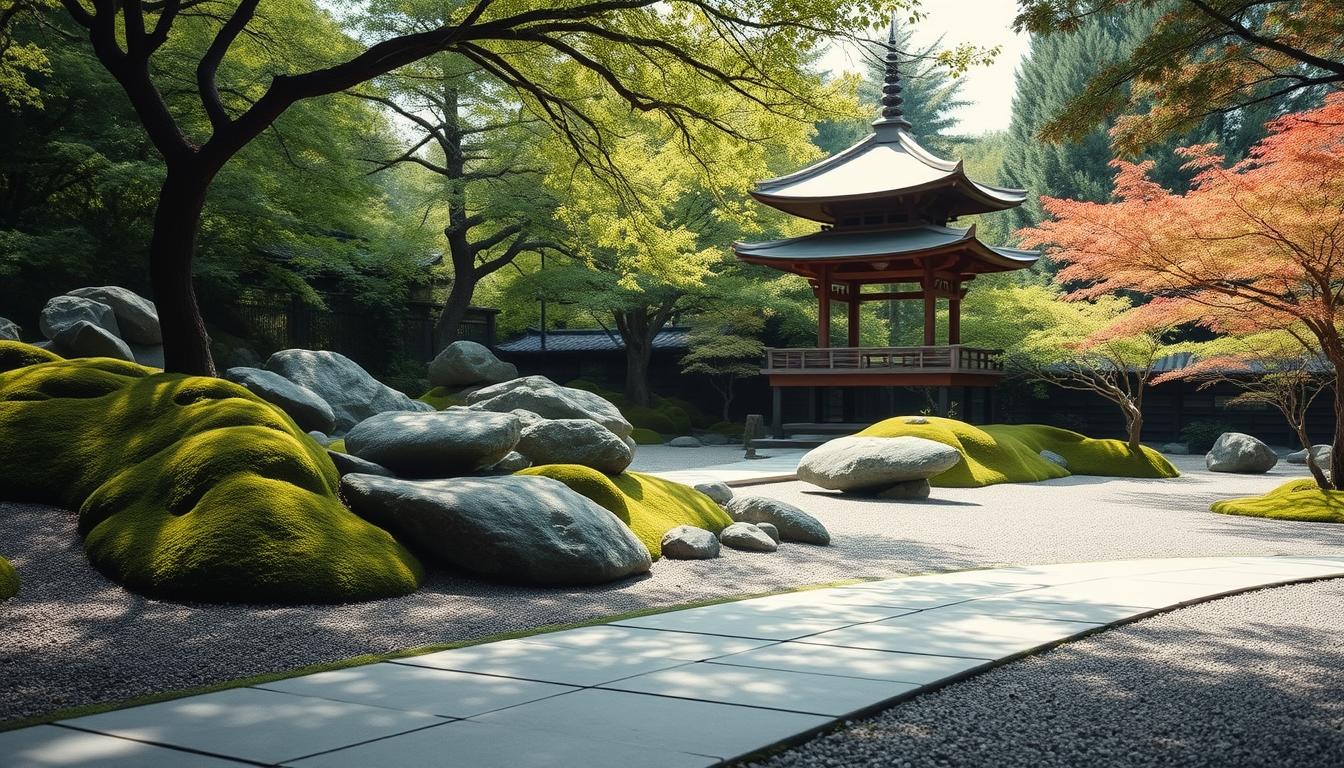Creating a peaceful retreat right in your backyard is easier than you think. Inspired by traditional Japanese designs, these spaces blend nature with mindfulness. Originally meant for meditation, they now bring serenity to modern homes.
What started in 14th-century temples has evolved into adaptable outdoor sanctuaries. Today, these designs fit any space or budget while keeping their calming essence. Their abstract forms symbolize natural landscapes, offering beauty without high maintenance.
Water features and minimalist arrangements create year-round appeal. Experts like Janet Loughrey highlight how these areas support mental wellness. Whether large or small, they turn any outdoor spot into a personal escape.
Key Takeaways
- Zen gardens originated as meditation spaces in Japanese temples.
- Modern versions blend tradition with personal style for any home.
- Low-maintenance designs work in small or large outdoor areas.
- Abstract elements represent nature while requiring little upkeep.
- Water features add movement despite traditional dry designs.
- These spaces align with today’s focus on mental well-being.
- Explore boho yard decor ideas for complementary styling.
Introduction to Zen Gardens
Monks first designed these landscapes as tools for deep meditation centuries ago. Today, they remain powerful spaces for contemplation, blending structured nature with mindful principles.

Originally found in Japanese temples, these arrangements used rocks and gravel to mimic waterfalls and mountains. Known as karesansui (dry landscape), this garden design eliminates water maintenance while symbolizing its flow through raked patterns.
Core Principles
| Principle | Meaning | Modern Application |
|---|---|---|
| Kanso (Simplicity) | Remove clutter | Limit plant varieties |
| Fukinsei (Asymmetry) | Balance unevenly | Offset rock placements |
| Shizen (Naturalness) | Avoid artificiality | Use unpolished stones |
| Yugen (Mystery) | Suggest, don’t reveal | Partially hide pathways |
| Datsuzoku (Unconventional) | Break norms | Mix textures boldly |
| Seijaku (Stillness) | Create calm | Add sound buffers |
Research from Washington State University shows these spaces lower cortisol levels by 17%. As garden expert Stacy Ling notes:
“Raking gravel or arranging stones becomes active meditation, redirecting stress into focus.”
Janet Loughrey recommends starting small—even a 5×5-foot area works. The key is choosing a quiet spot, away from distractions, to honor the traditional zen intent.
Traditional Zen Garden Elements
Rocks and gravel aren’t just materials—they’re metaphors in a centuries-old visual language. These elements form the backbone of dry landscape designs, where every placement carries meaning.

Rocks and Gravel: The Foundation
Stones symbolize eternity, often arranged in groups of three or five. The classic triad represents heaven, earth, and humanity. Larger boulders anchor the space, while smaller ones suggest islands or animals.
Gravel acts as water, with raked patterns mimicking waves or streams. Pea-sized gravel (3–8mm) works best, layered 2–3 inches deep for easy raking. Unlike sand, it resists wind erosion and lasts longer.
| Element | Purpose | Tips |
|---|---|---|
| Vertical Rocks | Represent trees/mountains | Bury 1/3 for stability |
| Flat Stones | Suggest earth or platforms | Space unevenly (fukinsei) |
| Raked Gravel | Mimics water flow | Use bamboo rake for crisp lines |
| Crushed Granite | Alternative to gravel | Choose light colors for contrast |
“Always position the largest stones first—they’re the ‘bones’ of your design. Avoid dark rocks in sunny spots; they overheat and harm nearby plants.”
Symbolism in Zen Design
Negative space is as vital as the elements themselves. Empty areas invite contemplation, echoing the traditional zen principle of ma (pause).
Plants add layers of meaning:
- Moss signifies age and patience.
- Bamboo embodies resilience and flexibility.
- Pine trees suggest endurance.
Stone lanterns, called tōrō, mark human presence subtly. Western adaptations often simplify symbolism, focusing more on aesthetics than spiritual intent.
Modern Zen Garden Adaptations
Today’s outdoor spaces blend ancient principles with contemporary flair, proving serenity isn’t bound by tradition. Over 63% of U.S. designs now include water features, from disappearing fountains to minimalist birdbaths. Even container setups have surged by 40%, adapting to urban small space needs.
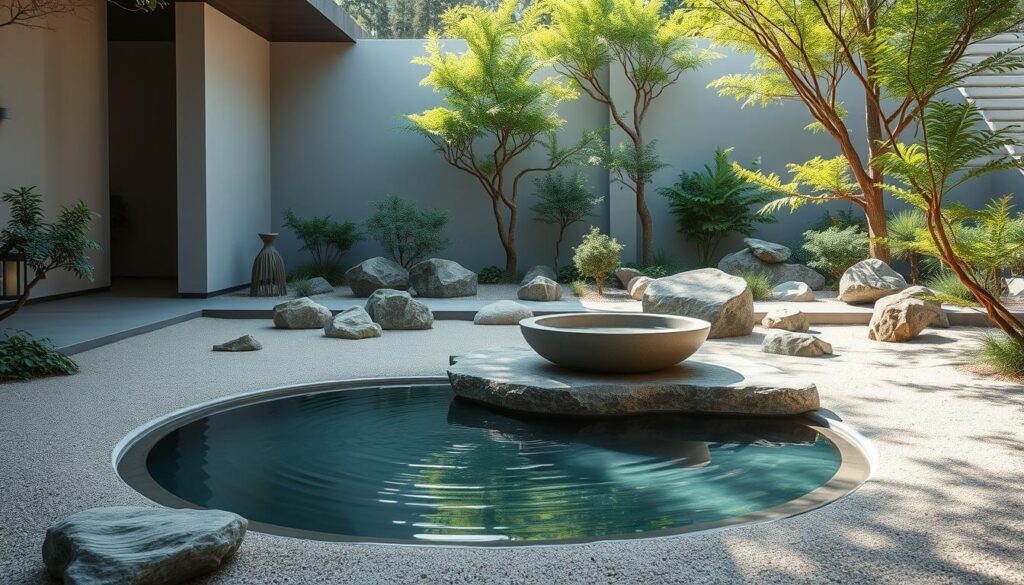
Western materials like corten steel and concrete now complement classic stone arrangements. These durable choices align with kanso (simplicity) while adding industrial contrast. Solar-powered lanterns replicate moonlight effects, a trick Stacy Ling champions:
“Soft solar lighting mimics traditional tōrō glow without wiring—ideal for backyard zen garden updates.”
Hybrid design thrives with Mediterranean succulents or prairie grasses, requiring little upkeep. Permeable pavers solve drainage issues, blending eco-smart function with clean lines. Even koi ponds get upgrades—Ling suggests submerged LED lights for nighttime drama.
For patios or balconies, try stacked stone planters with cascading sedums. These modern zen twists appear in the 15 ideas ahead, proving peace adapts to any lifestyle.
15 Inspiring Zen House Aesthetic Garden Ideas
Balance and harmony take center stage in these thoughtfully crafted designs. Whether you have a sprawling backyard or a tiny balcony, these layouts blend tradition with modern practicality. Each idea includes key materials, budget ranges, and skill levels to help you create your perfect retreat.

1. Rock and Sand Minimalist Garden
This design uses smooth river rocks and fine sand to create a serene, clutter-free space. Ideal for small areas (5×5 feet or larger), it requires basic raking skills. Budget: $200–$500. Janet Loughrey recommends using light-colored sand for better contrast.
2. Raked Gravel Meditation Space
Patterns in gravel mimic water flow, offering a meditative activity. Choose pea-sized gravel for easy maintenance. Skill level: Beginner. Stacy Ling suggests using a bamboo rake for crisp lines.
3. Koi Pond Oasis
A water feature that adds movement and life. Koi need 250+ gallons; pair with aquatic plants like water lettuce. Budget: $1,500+. Best for intermediate builders due to filtration needs.
4. Bamboo-Enclosed Sanctuary
Clumping bamboo (non-invasive) creates sound-dampening walls. Plant in containers to control growth. Budget: $600–$1,200. Tip: Space stalks unevenly for natural asymmetry.
5. Moss-Covered Tranquility
Soft moss thrives in shady spots, needing daily misting in dry climates. Budget: $300–$700. Janet Loughrey recommends sheet moss for quick coverage.
6. Stone Lantern Pathways
Granite lanterns guide footsteps while honoring traditional placement rules. Space them 6–8 feet apart. Budget: $800–$2,000. Skill level: Moderate.
7. Dry Landscape (Karesansui) Garden
A classic zen garden idea using rocks and crushed granite. Recycled materials cut costs. Budget: $400–$1,000. Rake weekly for maintained patterns.
8. Container Zen Gardens for Small Spaces
Whiskey barrels or stock tanks hold dwarf conifers and gravel. Budget: $150–$400. Perfect for balconies.
9. Wooden Bridge Accents
A arched bridge over gravel “water” adds whimsy. Use cedar for durability. Budget: $500–$1,200. Skill level: Advanced.
10. Moonlight Zen Garden with Solar Lighting
Soft solar lights mimic moonlight. Meditate under them post-sunset. Budget: $250–$600. Stacy Ling’s top pick for low-energy charm.
11. Zen Courtyard with Pruned Shrubs
Boxwoods or junipers trimmed into simple shapes. Budget: $700–$1,500. Prune monthly in growing season.
12. Waterfall and Stream Feature
A recirculating water feature powered by 50W solar panels. Budget: $2,000+. Sounds mask urban noise.
13. Teahouse or Pagoda Focal Point
A handcrafted teahouse elevates the space. Budget: $5,000+. Best for large yards with existing trees.
14. Zen Rock Garden with Succulents
Sedum and sempervivum thrive in rocky zones. Budget: $350–$800. Drought-tolerant and low-care.
15. Low-Maintenance Gravel and Fern Combo
Deer-resistant ferns pair with gray gravel. Budget: $300. Ideal for busy homeowners.
“For dog-friendly spaces, use flat stepping stones amid gravel—paws stay clean, and design stays intact.”
Designing Your Zen Garden
Practical steps turn any yard into a calming sanctuary. Smart garden design starts with analyzing your space and applying timeless principles. Whether adding water features or arranging rocks, each choice shapes the landscape’s mood.
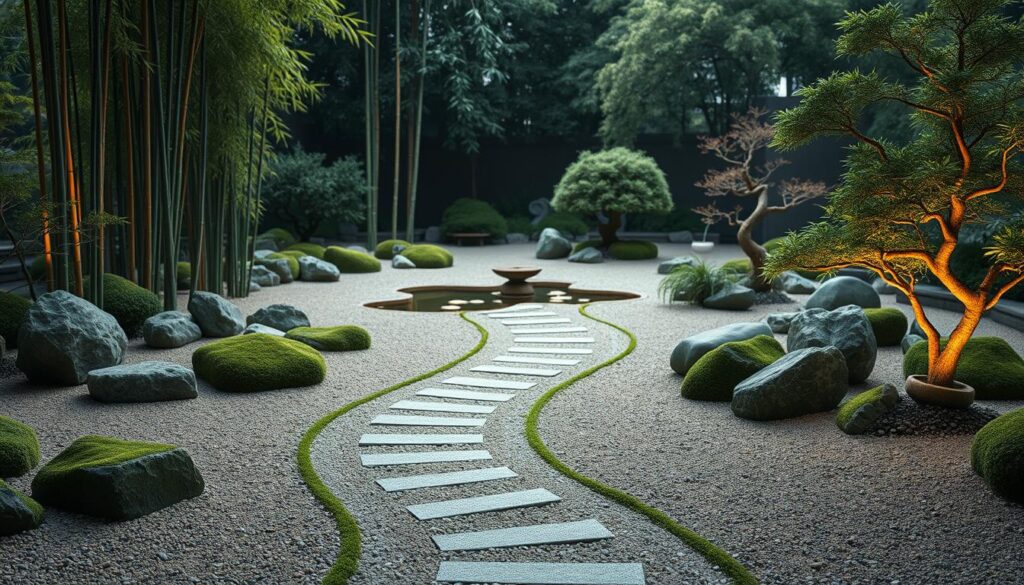
Picking the Perfect Location
North-facing slopes reduce water evaporation, ideal for dry landscape setups. Use SketchUp Free to map sun patterns and wind corridors. Janet Loughrey advises:
“Separate meditation zones from play areas. Living walls (like bamboo) soften noise, while dwarf trees create forced perspective.”
| Site Factor | Solution | Tool |
|---|---|---|
| Full Sun | Succulents/gravel | Sun calculator apps |
| High Wind | Low fences | Wind chimes (indicator) |
| Poor Drainage | Permeable pavers | Soil test kit |
Incorporating Water Features
Subtle water features like recirculating fountains need minimal upkeep. Stacy Ling recommends:
- Pump sizing: 50–100 GPH for small ponds.
- Slope calculations: 1-inch drop per 4 feet for natural flow.
- Acid-safe rocks (basalt) with soft water to prevent erosion.
For ADA compliance, keep paths 36+ inches wide. Always check utility lines before digging—call 811 for free U.S. locates.
Budget-Friendly Zen Garden Tips
Transforming your outdoor space into a peaceful retreat doesn’t have to break the bank. With smart choices and creativity, you can achieve a calming garden that fits any budget.
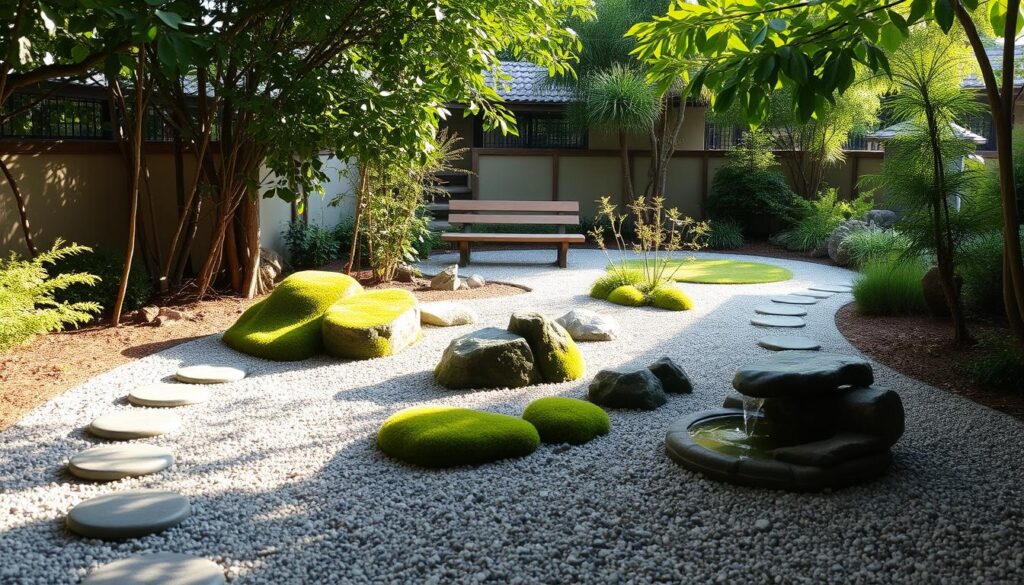
Salvage yards offer 60-80% savings on materials like stones and pavers. Stacy Ling shares:
“Facebook Marketplace is gold for discounted lanterns and containers. Last month, I found a $200 granite slab for $40.”
Affordable Alternatives
| Item | Premium Option | Budget Swap |
|---|---|---|
| Gravel | Pricey river rock ($5/sq ft) | Decomposed granite ($1.50/sq ft) |
| Ground Cover | Moss ($8/sq ft) | Creeping thyme ($3/sq ft) |
| Lighting | Wired fixtures ($120+) | Solar path lights ($25/set) |
Try these 10 DIY projects to save more:
- Concrete leaf stepping stones (use large hosta leaves as molds)
- Pallet benches (sand and seal with leftover stain)
- Old bathtub ponds (line with EPDM rubber)
Nature provides free materials too. Collect beach pebbles, fallen branches, or smooth river rocks. For plants, swap divisions with neighbors—hostas and sedums propagate easily.
Time your purchases right. Nurseries discount perennials by 50% in late fall. Check community tool libraries for rakes and pruners instead of buying.
Develop your garden in phases. Start with gravel and one focal rock, adding elements yearly. This way, costs spread out while enjoying progress.
Small-Space Zen Gardens
Urban living doesn’t mean sacrificing tranquility—small-space solutions bring peace to any apartment. Even a 18-inch-deep balcony can host a serene retreat with clever layouts and multi-level designs.
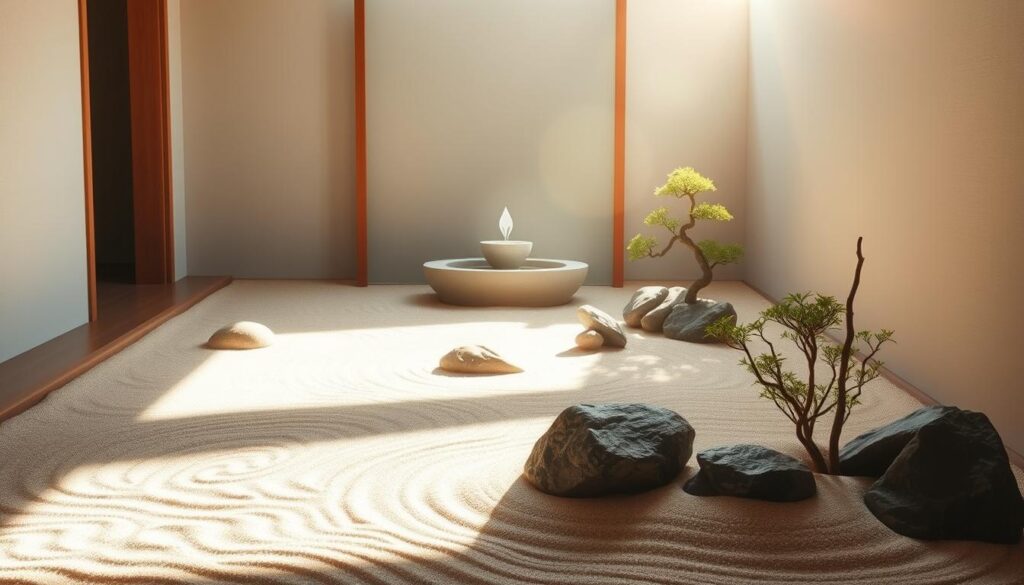
- Wall-mounted sand trays with miniature rakes
- Hanging bonsai or air plants in geometric planters
- Magnetic herb boxes for railing edges
Stacy Ling’s container garden hack: “Drill extra drainage holes and layer pebbles beneath soil—prevents root rot in shallow pots.”
For soundscapes, choose between:
- Copper wind chimes (low-maintenance)
- Tabletop fountains with submersible pumps
Foldable bamboo screens add privacy without permanent changes. Pair with rolling planter carts for flexible arrangements. Mirrors on walls create depth illusions in narrow spaces.
Rooftop? Check weight limits first. Lightweight materials like fiberglass rocks and resin lanterns reduce load stress. Dwarf Japanese maples thrive in patio containers—just ensure 6+ hours of sunlight.
Every detail, from fairy garden pagodas to solar-lit pebble paths, fosters calm. No yard? No problem. Peace grows where you plant it.
Maintaining Your Zen Garden
Keeping your outdoor sanctuary pristine requires smart, seasonal care. Regular upkeep ensures your garden remains a peaceful retreat year-round. Follow these steps to protect its beauty with minimal effort.
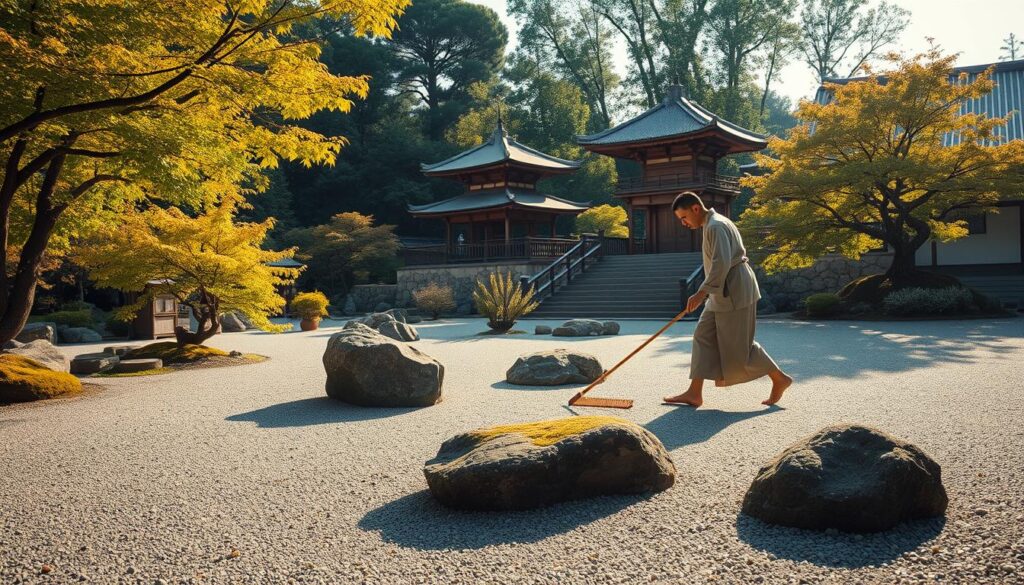
Seasonal Maintenance Checklist
Spring: Reseed moss patches and inspect irrigation systems. Janet Loughrey advises:
“Prune topiaries in early spring before new growth—sharp, clean cuts prevent disease.”
Summer: Control algae in water features with barley straw. Use shade cloths to protect delicate plants from scorching sun.
Fall: Install leaf barriers over gravel areas. Net ponds to catch falling debris.
Winter: Add antifreeze to pump systems. De-ice gravel paths with calcium chloride (pet-safe).
Tool and Material Care
- Oil bamboo rakes monthly to prevent cracking.
- Pressure wash rocks biannually to maintain color.
- Sharpen pruning shears before peak growing seasons.
Stacy Ling’s gravel fix: “Sprinkle corn gluten meal in spring—it prevents weeds naturally without harming plants.”
Pest and Soil Management
Deter slugs with copper tape or crushed eggshells. For container gardens, test soil pH every 6 months. Revive struggling moss with buttermilk sprays—a trick from Japanese horticulturists.
With these steps, your sanctuary stays serene through every season. A little time invested now saves hours later.
Conclusion
Your journey to tranquility begins with just one stone. A zen garden isn’t about perfection—it’s a living, evolving space that grows with you.
NIH research confirms 92% of owners feel calmer after creating theirs. Start small: a container with gravel, a single lantern. Let simplicity and stillness guide you.
As Stacy Ling reminds us, even cracked rocks hold irreplaceable beauty. Share your progress with #ZenGardenJourney, or join local workshops to deepen your practice.
Breathe. Rake. Repeat. Your peaceful retreat awaits.

